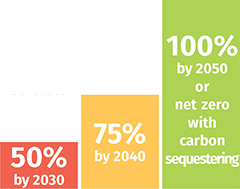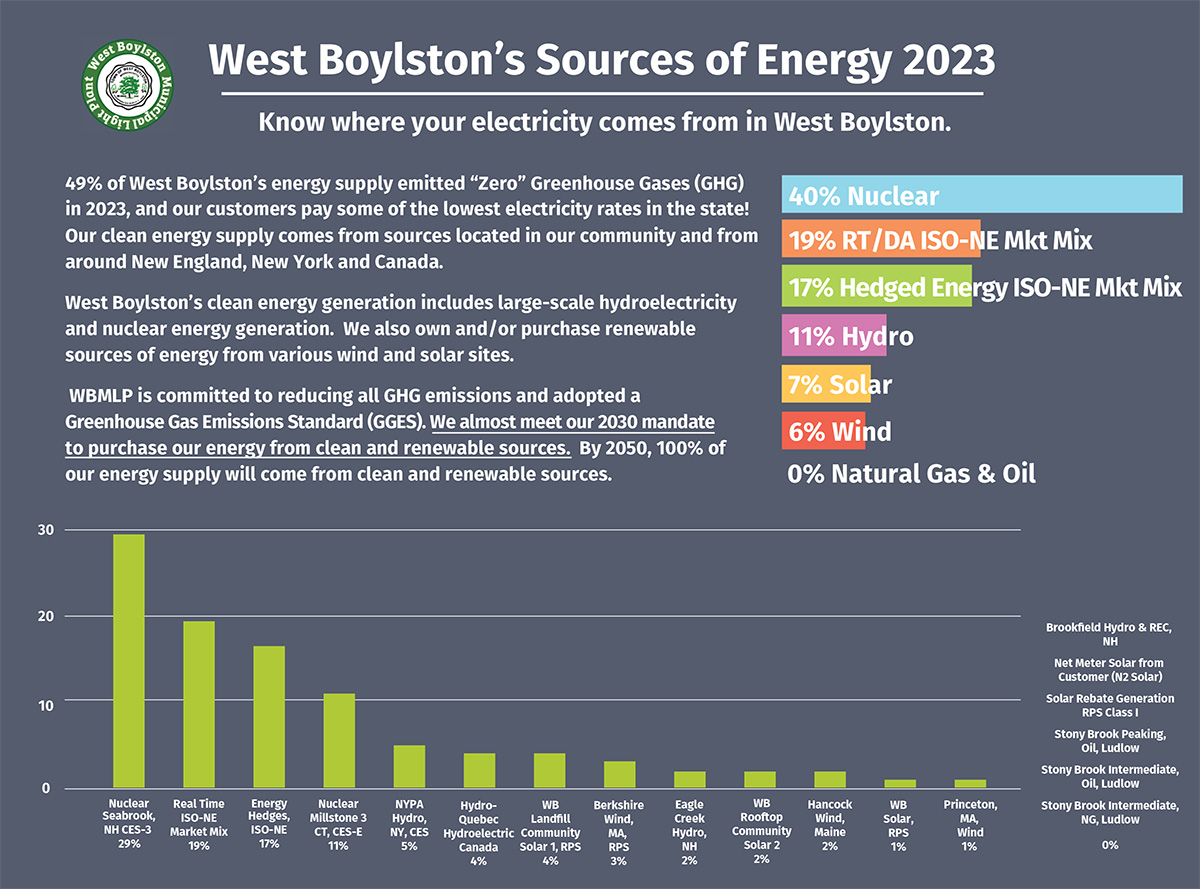Electrification in West Boylston
West Boylston and the “Energy Sector” in Massachusetts
West Boylston recognizes the importance of protecting our environment and reducing GHG emissions from our energy sources. In February 2020, WBMLP’s Board of Light Commissioners adopted a Greenhouse Gas Emissions Standard (GGES). Our GGES supports the Commonwealth’s GHG emission reduction goals required under the GWSA, while acknowledging and preserving the local control of our municipal lighting plant. WBMLP’s GGES requires WBMLP to meet the same carbon emission reduction standards applied to the distribution companies and competitive energy suppliers.

West Boylston is extremely proud of its contribution towards reducing GHG emissions through existing clean generation, long-term power supply projects and funding of energy efficiency and conservation programs for our customers. In 2023, WBMLP purchased 49% of its annual energy supply from clean and renewable solar, wind, nuclear, and hydroelectric generation.

What does this mean for WBMLP?
As your locally controlled utility and energy supplier, WBMLP is expected to completely decarbonize the energy supply delivered to our residents and businesses. This means we need to start planning to purchase additional clean and renewable energy in time for the 2030, 2040 and final 2050 goals.
WBMLP is also expected to enlarge and operate its electrical distribution system so that other sectors of our state’s economy can switch from fossil fuels to electricity. This means converting gasoline and diesel fueled transportation to electric vehicles (EV), and converting natural gas, oil, and propane fueled heating and cooling systems for buildings to our more efficient and decarbonized electricity supply.
WBMLP will do its best to maintain the lowest possible electricity rates and highest level of reliability, as we increase the size of our electric distribution system and increase the supply of clean and renewable energy. What does this mean for you?
WBMLP is already planning for 2050 and you should too. Homeowners and businesses should consider the following when replacing or upgrading vehicles, heating and cooling systems, domestic hot water heating systems and other appliances using electricity.
Electrification: The Definition
Switching from fossil fuels to electric transportation and electric building heating and cooling systems is called "electrification". Electrification will increase the demand placed on our distribution system and significantly increase the amount of clean and renewable energy we must supply as we electrify these two sectors going forward. Overall, electrification increases efficiency, reduces GHG emissions and lowers operating costs for our customers.
What Can You Do To Help?
- • Convert to Air or Ground Source Electric Heat Pump heating and cooling
- • Install Smart Thermostats to minimize heating and cooling operation
- • Convert to Electric Heat Pump hot water heaters
- • Convert to Electric Vehicles
- • Install Solar Energy and/or Battery Storage systems
- • Install Solar Hot Water Storage systems
- • Conserve energy and purchase the most Energy Efficient Appliances
- Purchase Most Efficient Energy Star Refrigerators
- Purchase Most Efficient Energy Star Clothes Washers
- Purchase Heat Pump Clothes Dryers
WBMLP's Cost Per BTU
West Boylston’s energy supply is less expensive and emits fewer GHGs compared to the combustion of gasoline, diesel, heating oil, natural gas and propane used in either the transportation or building sectors.
For example, West Boylston residents use a variety of systems and fuels to heat their home. When you calculate the cost per BTU for each heating fuel, electric heat-pump heating is the most efficient and lowest cost.

Residential & Commercial Buildings
Energy consumption by Residential and Commercial buildings was responsible for 27% of the states GHG emissions in 2017. Oil and natural gas use for building heating is the largest contributor to GHG emissions in this sector and is followed using these fuels for hot water heating, cooking, and other home chores such as drying clothes.
Electrification in buildings replaces fossil-fueled equipment for Space Heating/Cooling and Hot Water, with Heat Pump technologies that operate at significantly higher efficiencies—and lower operating costs.
Air-source Heat Pumps (sometime called mini-splits) are the dominant technology for Residential Heating and Cooling applications. Ground-source systems are also effective, especially in new construction.
For Commercial buildings, Air-source Heat Pumps, Ground-source systems, and Variant Refrigerant Flow systems, offer great opportunities for electrification.
Heat Pump Water Heaters are a great electrification option for water heating in both Residential and Commercial buildings.
Transportation (light duty cars and trucks)
The Transportation sector emitted 42% of the state’s GHG emissions in 2017 and accounts for the largest portion of the Commonwealth’s emissions. Light-duty vehicles (LDVs) or personal cars and light trucks, are responsible for 58% of this sector's GHG emissions. Replacing all petroleum-based LDVs with Battery Electric Vehicles is required to achieve net-zero statewide emissions by 2050.